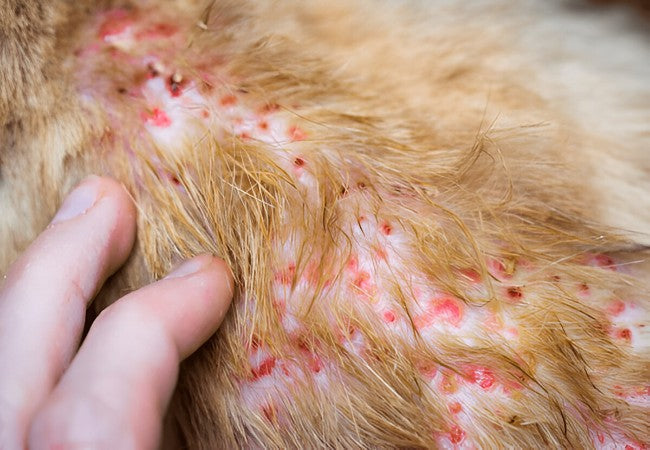Veterinary Guide to Canine Cutaneous Vasculitis 2025 🩺🐶

In this article
Veterinary Guide to Canine Cutaneous Vasculitis 2025 🩺🐶
By Dr. Duncan Houston BVSc
🧬 What Is Cutaneous Vasculitis?
Cutaneous vasculitis is inflammation targeting vessels in the skin—arterioles, capillaries, or venules—triggered by immune complexes, drug reactions, infections, neoplasia, food allergies, or idiopathic causes. This damages vessel walls, leading to skin necrosis, edema, ulceration, and often systemic signs.
👥 Who Is Affected & What Triggers It?
- Affects dogs of all ages and breeds; breeds like German Shepherds, Dachshunds, Rottweilers, Jack Russells, Greyhounds, and Poodles are frequently noted.
- •Idiopathic: ~45–55% with no clear cause.
- •Medication or vaccine reactions: Common triggers (NSAIDs, antibiotics, vaccines).
- •Infections: Tick-borne diseases (ehrlichiosis, RMSF), bacterial/fungal/parasitic agents.
- •Neoplastic: Paraneoplastic phenomena from lymphoma, mast cell tumors.
- •Food allergies: May present as urticarial vasculitis.
- •Autoimmune disease, Including SLE or immune complexes.
👀 Clinical Signs & Presentation
- Early: Purpura—purple pinpoint bleeding, edematous lesions, and scaling on pressure points, paws, tail, ears, scrotum.
- Progressive: Development of ulcers, necrosis, hemorrhagic bullae, panniculitis.
- Skin changes: Alopecia, crusting, hyperpigmentation, and painful lesions.
- Systemic signs: Fever, lethargy, inappetence, depression—especially with systemic involvement.
- Severe syndromes: Conditions like proliferative thrombovascular necrosis of pinnal tips and Alabama Rot (cutaneous-renal vasculopathy) may occur.
🔍 Diagnostic Workup
- History & exam: Detail medication, vaccine, diet, tick exposure, lesion distribution.
- Laboratory testing: CBC, chemistry, urinalysis to assess systemic involvement; tick titers if indicated.
- Skin biopsy: Gold standard—reveals leukocytoclastic or lymphocytic inflammation of vessel walls.
- Ruling out systemic disease: Imaging or further tests if organ systems are involved.
- Syndrome-specific tests: ANA/ANCA if autoimmune suspected; renal workup for Alabama Rot.
🛠️ Treatment & Management
1. Remove or Treat Underlying Causes
- Discontinue offending drugs or vaccines; consider a food trial for allergy.
- Treat infections with appropriate antibiotics, antifungals, or tick control.
- Evaluate for neoplasia and refer for oncologic therapy if needed.
2. Immunomodulatory & Anti-inflammatory Therapy
- Glucocorticoids: Prednisone/prednisolone 2 mg/kg/day initially; taper to the lowest effective dose.
- Common adjuncts: Pentoxifylline 25 mg/kg BID, dapsone 1 mg/kg Q8 h, niacinamide + tetracycline, azathioprine, cyclosporine—especially in steroid tolerance issues.
- Topicals: Tacrolimus ointment, medicated shampoos, and ulcer dressings to soothe local lesions.
- NSAIDs: In mild cases only—under close monitoring.
3. Supportive Care
- Pain control (tramadol, gabapentin).
- Wound management—cleaning, sterile bandaging.
- Protective clothing and sun shields to avoid trauma and photosensitivity.
- Hydration, nutrition support—anti-inflammatory or hypoallergenic diets.
📈 Prognosis & Monitoring
- Prognosis varies—mild cases often respond well; severe or systemic forms are guarded.
- Regular monitoring: CBC, biochemistry every 4–8 weeks while on medications, then less often after remission.
- Watch for relapse—new lesions, systemic signs, or drug exposures should prompt reassessment.
- Some dogs may require lifelong maintenance therapy or episodic immunosuppression.
🏡 Home Care Guidelines
- Protect skin from trauma and sun exposure—avoid rough play and apply clothing if needed.
- Use gentle, hypoallergenic grooming products.
- Administer medications reliably; log lesion changes daily.
- Ensure nutritious diet aligned with anti-inflammatory goals.
- Consult vet if signs of infection, renal signs, or unusual systemic signs emerge.
📱 Ask A Vet Telehealth Integration
- 📸 Photo uploads of lesions for triage and progression tracking.
- 🔔 Reminder tools for meds and tapering schedules.
- 🧾 Lab alerts for monitoring CBC/chemistries while on immunosuppression.
🎓 Case Spotlight: “Ruby” the Rottie
Ruby, a 4‑year‑old Rottweiler, developed painful purpura and ulceration on her ears and paws shortly after doxycycline. Biopsy confirmed leukocytoclastic vasculitis. Treatment included stopping doxycycline, prednisone (2 mg/kg), pentoxifylline, and topical tacrolimus. Lesions healed over 14 days; prednisone was tapered over two months. Minor flare-ups each spring are now managed with pentoxifylline and sun protection. Ask A Vet reminders helped monitor progress through pictures and adjust therapy remotely. 🐶🌟
🔚 Key Takeaways
- Cutaneous vasculitis is immune-mediated vessel inflammation in dogs; skin lesions may signal systemic disease.
- Triggers include medications, infections, food allergens, neoplasia, or unknown causes.
- Diagnosis requires history, biopsy, and rule-out of systemic conditions.
- Treatment: remove cause, immunosuppressives, adjuncts (pentoxifylline, dapsone), supportive skin care.
- Prognosis varies—monitor closely for relapse and systemic signs.
- Ask A Vet telehealth provides lesion tracking, medication support, lab scheduling, topical delivery, and diet advice 🐾📱
Dr Duncan Houston BVSc, founder of Ask A Vet. Download the Ask A Vet app to get expert, remote care for your dog’s vasculitis—from diagnosis, treatment, monitoring, to flare prevention 📲🐶






